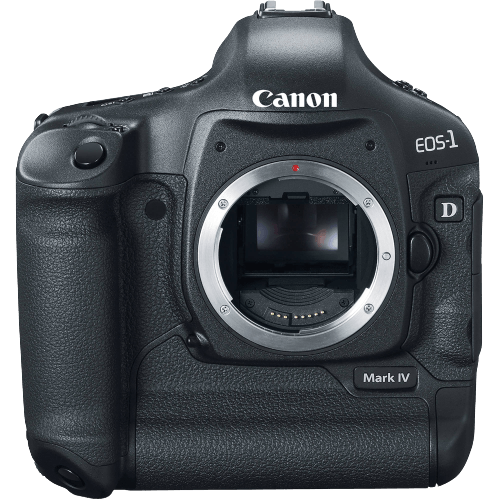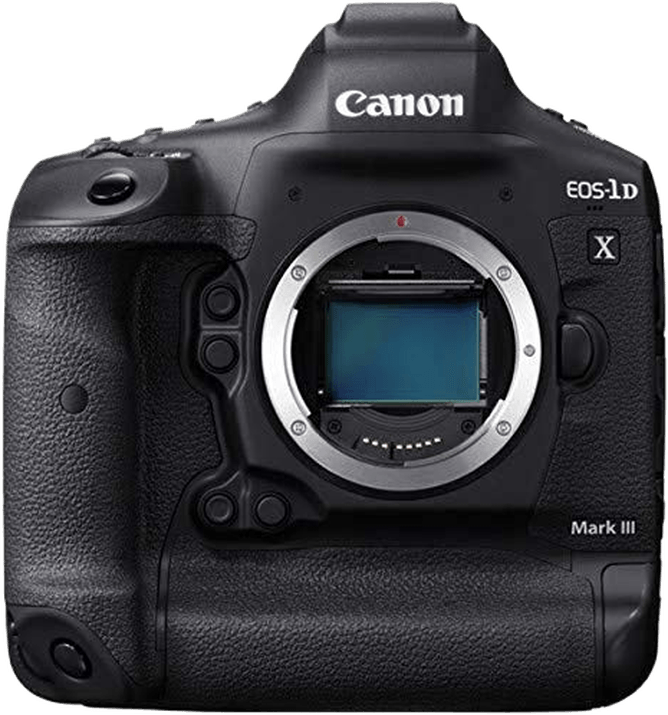Canon EOS 1D Mark IV vs EOS 1D X Mark III Comparison
Canon EOS 1D Mark IV

Canon EOS 1D X Mark III

The Canon EOS 1D X Mark III is the winner with a score of 75/100, outscoring the Canon EOS 1D Mark IV by 21 points. Both cameras are DSLRs and share similar dimensions, with the 1D X Mark III being slightly larger at 158 x 168 x 83mm compared to the 1D Mark IV’s 156 x 157 x 80mm.
The 1D X Mark III has a clear advantage in weight, coming in at 738g (1.63lbs) compared to the heavier 1D Mark IV at 1230g (2.71lbs). This makes it a more convenient option for photographers who need to carry their gear for extended periods.
The 1D Mark IV, released in 2009, has a lower launch price of $5840, making it more affordable than the 1D X Mark III, which was released in 2020 with a launch price of $6500. However, the 1D X Mark III’s higher score reflects its superior performance and features, making it a better investment for professional photographers.
Taking these points into consideration, the Canon EOS 1D X Mark III is a superior camera in terms of performance and portability, while the Canon EOS 1D Mark IV may be a more budget-friendly option for those prioritizing affordability.
Canon 1D Mark IV vs 1D X Mark III Overview and Optics
The Canon EOS 1D X Mark III outperforms the Canon EOS 1D Mark IV in optics, with a score of 74/100 compared to the Mark IV’s 54/100. Both cameras share several specifications, such as the CMOS sensor type, Canon EF lens mount, and the absence of image stabilization.
The 1D X Mark III excels in multiple aspects. Firstly, it boasts a higher megapixel count of 20.1 compared to the 16.1 megapixels of the 1D Mark IV. This allows for larger and more detailed images. Additionally, the 1D X Mark III has a faster shooting speed of 20 frames per second, doubling the 10 frames per second of the 1D Mark IV. This enables capturing fast-moving subjects more effectively. Furthermore, the 1D X Mark III has a superior sensor, as evidenced by its DXOMARK score of 91, compared to the 1D Mark IV’s score of 74. This results in better image quality and low-light performance. Lastly, the 1D X Mark III’s full-frame sensor size provides a broader field of view and improved image quality compared to the 1D Mark IV’s APS-H sensor size.
Despite its lower score, the 1D Mark IV has a noteworthy advantage in being equipped with the Digic 4 processor, which is known for its reliability and consistent performance. However, the 1D X Mark III features the newer and more powerful Digic X processor, providing faster processing and improved performance.
Taking all factors into consideration, the Canon EOS 1D X Mark III’s superior optics make it the better choice for photographers seeking higher image quality, faster shooting speeds, and better low-light performance. The Canon EOS 1D Mark IV remains a reliable option but falls short in comparison to the 1D X Mark III’s advancements.
Canon 1D Mark IV vs 1D X Mark III Video Performance
The Canon EOS 1D X Mark III outperforms the Canon EOS 1D Mark IV in video capabilities with a video score of 91/100, a significant 48-point difference from the Mark IV’s score of 43/100. Despite this difference, both cameras share some common video specs, such as the ability to record Full HD videos at 1920 x 1080 resolution. However, the 1D X Mark III has several advantages that contribute to its higher score.
The 1D X Mark III exceeds the Mark IV in terms of maximum video resolution and dimensions, offering 4K video recording at 4096 x 2160. This provides users with higher video quality and more detailed footage. Furthermore, the 1D X Mark III has a much higher maximum video frame rate, reaching 120fps, while the Mark IV is limited to 30fps. The higher frame rate allows for smoother video playback and better slow-motion capabilities.
Additionally, the 1D X Mark III features built-in time-lapse functionality, enabling users to create time-lapse videos without the need for external accessories or software. The Mark IV, on the other hand, lacks this feature.
The 1D Mark IV does not have any notable advantages over the 1D X Mark III in terms of video capabilities. The significant difference in their video scores highlights the superiority of the 1D X Mark III in this aspect.
Given these points, the Canon EOS 1D X Mark III is the clear winner in terms of video capabilities. Users who prioritize video quality, higher resolution, and more advanced features should opt for the 1D X Mark III. The Canon EOS 1D Mark IV may still be suitable for those who require basic video functionality, but it falls short compared to the 1D X Mark III.
Canon 1D Mark IV vs 1D X Mark III Features and Benefits
The Canon EOS 1D X Mark III wins the feature comparison with a score of 74/100, while the Canon EOS 1D Mark IV scores 54/100. Both cameras share some common specifications, such as screen size and the absence of a flip screen and Bluetooth connectivity.
The Canon EOS 1D X Mark III excels in several areas, including a larger screen size of 3.2 inches compared to the 1D Mark IV’s 3 inches. The 1D X Mark III also boasts a higher screen resolution of 2,100,000 dots, while the 1D Mark IV has a resolution of 920,000 dots. This difference results in a crisper and clearer display on the 1D X Mark III. Additionally, the 1D X Mark III has a touchscreen, GPS, and WIFI capabilities, whereas the 1D Mark IV lacks these features.
Despite its lower score, the Canon EOS 1D Mark IV still has some advantages. However, based on the provided specifications, the 1D Mark IV does not surpass the 1D X Mark III in any particular feature.
Given these points, the Canon EOS 1D X Mark III is a more advanced camera in terms of features compared to the Canon EOS 1D Mark IV. The 1D X Mark III’s higher score reflects its superior specifications in screen size, screen resolution, and additional features such as touchscreen, GPS, and WIFI. While the Canon EOS 1D Mark IV may still be a suitable choice for some photographers, the 1D X Mark III is the clear winner in this comparison.
Canon 1D Mark IV vs 1D X Mark III Storage and Battery
The Canon EOS 1D X Mark III outperforms the Canon EOS 1D Mark IV in storage and battery with a score of 87/100, compared to the Mark IV’s 48/100. Both cameras lack USB charging capabilities.
The 1D X Mark III boasts a significant advantage with its two memory card slots, accepting CFexpress Type B cards. This feature allows for greater storage capacity and flexibility. Additionally, the 1D X Mark III has a remarkable battery life of 2850 shots, powered by the LP-E19 battery.
On the other hand, the 1D Mark IV possesses only one memory card slot, compatible with SD/SDHC and Compact Flash (Type I or II, UDMA) cards. Its battery life is limited to 1500 shots, using the LP-E4 battery type.
When comparing storage and battery capabilities, the Canon EOS 1D X Mark III emerges as the superior choice due to its increased memory card slots and extended battery life. While the 1D Mark IV offers compatibility with various memory card types, it falls short in overall performance in this area.
Canon EOS 1D Mark IV vs EOS 1D X Mark III – Our Verdict
Are you still undecided about which camera is right for you? Have a look at these popular comparisons that feature the Canon EOS 1D Mark IV or the Canon EOS 1D X Mark III:

